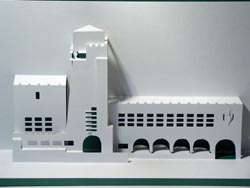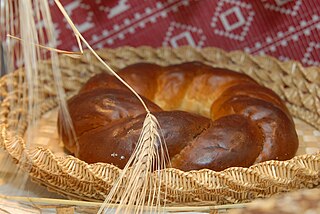
Wycinanki ( [vɨt͡ɕiˈnaŋkʲi] ) in Poland or Vytynanky (Витина́нки) in Ukraine or Vycinanki (Выцінанкі) in Belarus, is a Slavic version of the art form of papercutting, popular in Belarus, Poland, and Ukraine.

Wycinanki ( [vɨt͡ɕiˈnaŋkʲi] ) in Poland or Vytynanky (Витина́нки) in Ukraine or Vycinanki (Выцінанкі) in Belarus, is a Slavic version of the art form of papercutting, popular in Belarus, Poland, and Ukraine.

Vycinanka is also known as vyrazanka or vystryhanka. Viačaslaŭ Dubinka was key in reviving in Belarus the folk art of paper cutting images with scissors. [1] Repeatedly the winner of international competitions, he left behind thousands of images with this technique. His works have adorned calendars, business cards, notepads, postcards and other items. [1] [2]

Polish wycinanki became a popular folk craft in the mid-1800s. [3]
Wycinanki originated with shepherds cutting designs out of tree bark and leather. [4] Colorful wycinanki were pasted on furniture or roof beams as decoration, hung in windows, and given as gifts.
Wycinanki vary by region. For example, wycinanki created in the Kurpie region are typically all one color, while wycinanki from the Łowicz region are multicolored. Techniques include cutting, clipping, punching, tearing, and carving of paper, as well as nalepianki in which multiple layers are glued together.
Subject matter includes peacocks, roosters, and other birds; circular or star-shaped medallions (gwiazdy); flowers; and annual holidays such as Easter and Christmas. In some towns and villages competitions evolved to create the most beautiful wycinanki. Traditionally done for relaxation in rural Poland, the techniques were passed down through generations, with new themes and ideas developing as the papercuttings became more detailed and intricate.
The Polish Pavilion at the 2010 World Expo in Shanghai is based on a wycinanki design.
Historical evidence suggests that vytynanky began to be made in Ukraine at the end of the fifteenth to early sixteenth century, but it took quite some time before they became an integral part of the decorative arts practiced at the grass roots level. During the nineteenth century decorative paper cutouts spread all across the Ukrainian countryside. [5]
The word itself, vytynanky, gained currency in the early twentieth century, but there were many other, regional words that were used too — stryhuntsi, khrestyky or kvity to mention but a few. The vytynanky shapes were of many kinds and represented stylized figures of people, animals and plants. Ethnographers and art historians began to study the art of vytynanky, and artists began to seek inspiration for their art in vytynanky. Articles and essays were published, vytynanky began to be collected. Vytynanky were displayed at exhibitions of the Ukrainian decorative and applied arts alongside traditional pottery, embroidery, rugs and other items. [5]
Vytynanky that were made for the occasions of religious feasts and holidays were more decorative than the ones used for everyday decoration. Christmas and Easter called for vytynanky in the shapes of angels, churches or even whole evangelical scenes to be pasted prominently on the walls. Marriages saw vytynanky in the shapes of doves, flowers, or the ones that formed “trees of life.” [5]
{{cite web}}: CS1 maint: bot: original URL status unknown (link)
Egg decorating is the art or craft of decorating eggs. It has been a popular art form throughout history because of the attractive, smooth, oval shape of the egg, and the ancient associations with eggs as a religious and cultural symbol. Egg decorating has been associated with Easter in recent times, but was practiced independently by many ancient cultures.

The art of paper cutting in China may date back to the 2nd century CE, when paper was invented by Cai Lun, a court official of the Eastern Han dynasty.

Decoupage or découpage is the art of decorating an object by gluing colored paper cutouts onto it in combination with special paint effects, gold leaf, and other decorative elements. Commonly, an object like a small box or an item of furniture is covered by cutouts from magazines or from purpose-manufactured papers. Each layer is sealed with varnishes until the "stuck on" appearance disappears and the result looks like painting or inlay work. The traditional technique used 30 to 40 layers of varnish which were then sanded to a polished finish.

Christmas ornaments, baubles, globes, "Christmas bulbs", or "Christmas bubbles" are decoration items, usually to decorate Christmas trees. These decorations may be woven, blown, molded, carved from wood or expanded polystyrene, or made by other techniques.

Origamic architecture is a form of kirigami that involves the three-dimensional reproduction of architecture and monuments, on various scales, using cut-out and folded paper, usually thin paperboard. Visually, these creations are comparable to intricate 'pop-ups', indeed, some works are deliberately engineered to possess 'pop-up'-like properties. However, origamic architecture tends to be cut out of a single sheet of paper, whereas most pop-ups involve two or more. To create the three-dimensional image out of the two-dimensional surface requires skill akin to that of an architect.

Papel picado is a traditional Mexican decorative craft made by cutting elaborate designs into sheets of tissue paper. Papel picado is considered a Mexican folk art. The designs are commonly cut from as many as 40-50 colored tissue papers stacked together and using a guide or template, a small mallet, and chisels, creating as many as fifty banners at a time. Papel picado can also be made by folding tissue paper and using small, sharp scissors. Common themes include birds, floral designs, and skeletons. Papel picados are commonly displayed for both secular and religious occasions, such as Easter, Christmas, the Day of the Dead, as well as during weddings, quinceañeras, baptisms, and christenings. In Mexico, papel picados are often incorporated into the altars (ofrendas) during the Day of the Dead and are hung throughout the streets during holidays. In the streets of Mexico, papel picados are often strung together to create a banner that can either be hung across alleyways or displayed in the home.

Kolach or kalach is a traditional bread found in Central and Eastern European cuisines, commonly served during various special occasions – particularly wedding celebrations, Christmas, Easter, and Dożynki. The name originates from the Old Slavonic word kolo (коло) meaning "circle" or "wheel". Korovai is sometimes categorised as a type of kolach.

Papercutting or paper cutting is the art of paper designs. Art has evolved all over the world to adapt to different cultural styles. One traditional distinction most styles share is that the designs are cut from a single sheet of paper as opposed to multiple adjoining sheets as in collage.

The tradition of egg decoration in Slavic cultures originated in pagan times, and was transformed by the process of religious syncretism into the Christian Easter egg. Over time, many new techniques were added. Some versions of these decorated eggs have retained their pagan symbolism, while others have added Christian symbols and motifs.

Cake decorating is the art of decorating a cake for special occasions such as birthdays, weddings, baby showers, national or religious holidays, or as a promotional item.

Cookie decorating dates back to at least the 14th century when in Switzerland, springerle cookie molds were carved from wood and used to impress Biblical designs into cookies.

Ukrainian embroidery occupies an important place among the various branches of Ukrainian decorative arts. Embroidery has a rich history in Ukraine, and has long appeared in Ukrainian folk dress as well as played a part in traditional Ukrainian weddings and other celebrations. Appearing all across the country, Ukrainian embroidery varies depending on the region of origin. From Poltava, Kyiv, and Chernihiv in the east, to Volyn and Polissia in the northwest, to Bukovina, and the Hutsul area in the southwest, the designs have a long history which defines its ornamental motifs and compositions, as well as its favorite choice of colors and types of stitches.

SFC Slutsk is a Belarusian association football club based in Slutsk, Minsk Oblast.

Jewish paper cutting is a traditional form of Jewish folk art made by cutting figures and sentences in paper or parchment. It is connected with various customs and ceremonies, and associated with holidays and family life. Paper cuts often decorated ketubbot, Mizrahs, and ornaments for festive occasions. Paper cutting was practiced by Jewish communities in both Eastern Europe and North Africa and the Middle East for centuries and has seen a revival in modern times in Israel and elsewhere.

An Easter palm is a traditional Lithuanian and Polish symbolic decoration associated with Palm Sunday. Barbara Ogrodowska states that the ceremonial palm branch is the "most important attribute" of Palm Sunday in Poland. Communities of Polish emigrants, such as those in the United States, observe the tradition of making of Easter palms as well.
Oleksandr Miroshnikov is a Ukrainian artist, stone-carver and jeweler. He is an honored Master of Folk Art of Ukraine, a stone-carving artist, a member of the National Union of Artists of Ukraine and an honorary citizen of Mykolaiv in the Lviv region.

National symbols are the sacred attributes for Ukrainian people. In Ukrainian graphics there exist a number of symbols and images from national songs, legends. Such symbols and imagery are used in national customs and rituals. They are reproduced in embroidery on national costumes, ritual cloth—rushnyks, painted on crockery, in forged products, in carving, in bas-relief house decoration, in hearth painting, pottery, engraving and also in Ukrainian traditional Easter eggs—pysanky.
Wilhelm Hunt Diederich was a German American sculptor and painter.

Uladzimier Teraŭski was a Belarusian composer, choirmaster and a victim of Stalin’s purges. He wrote music to a number of popular Belarusian songs such as Vajacki Marš and Kupalinka.
Kupalinka is a popular Belarusian song described as a “musical business card of Belarus”.